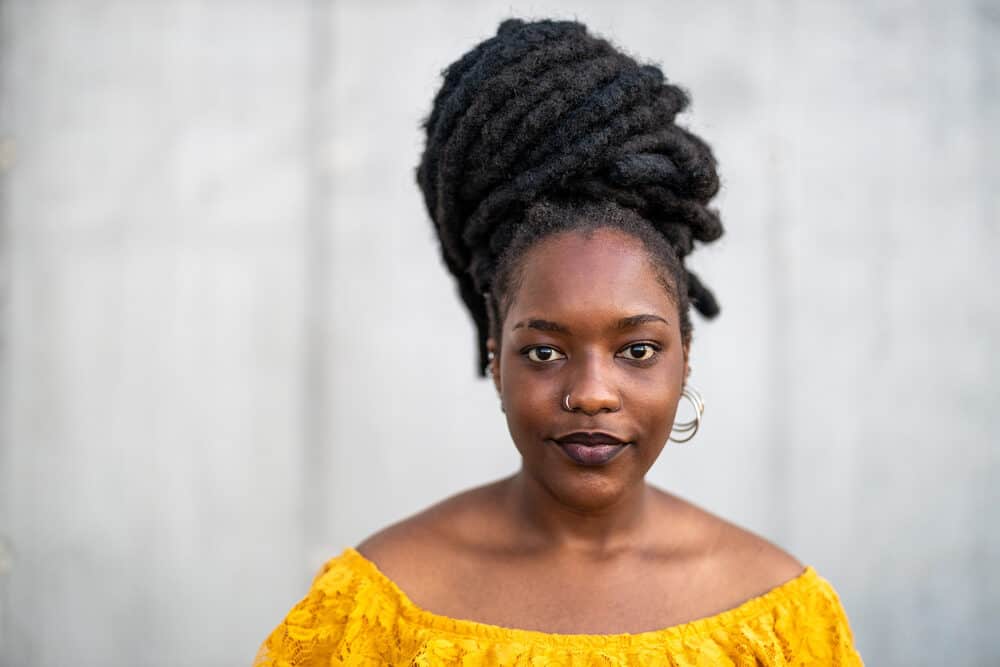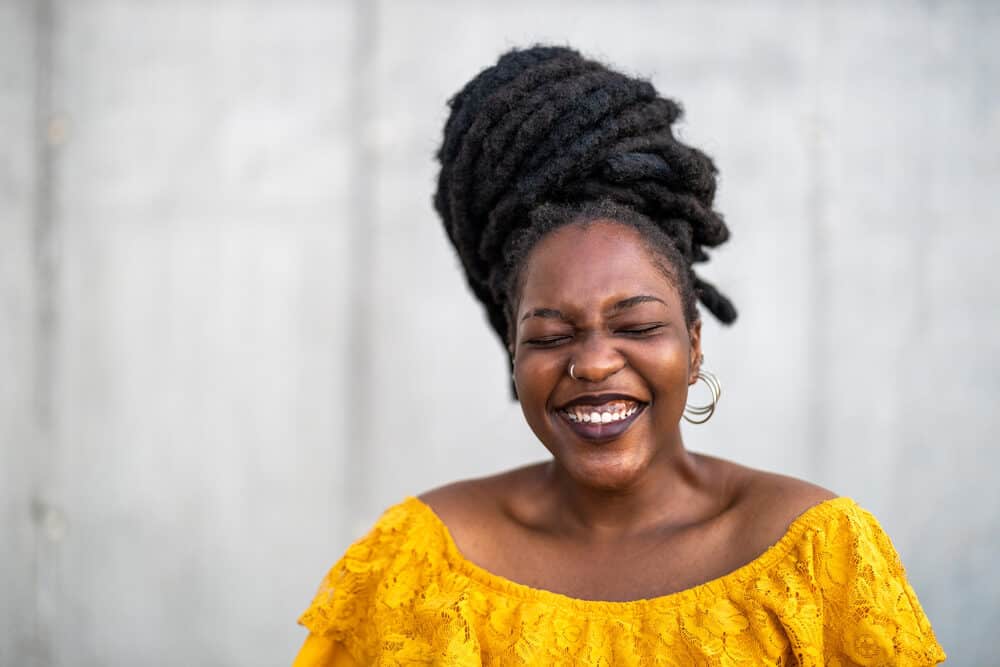
Are you thinking about growing dreads? If so, it’s in your best interest to learn everything you possibly can about them before taking the plunge.
One of the main questions people have shortly after being introduced to locs is, “How long does it take to grow dreads?” The answer to that question is a bit complex, but we’ll get to the bottom of it in this article!
Table of Contents
How Long Does It Take To Grow Dreads

It can take anywhere from 10 months to 2 years to grow fully mature dreadlocks, but for most people, the process takes 18 to 24 months.
When we say “fully mature,” we are referring to the rooted stage (also called the adult stage), where all of your locs are fully formed, closed at the ends, and have considerable length.
Here are the stages of loc maturation:
- Baby Loc Stage: The baby loc stage, where your locs are new and fragile, lasts for one to 6 months.
- Budding Stage: The budding stage, which is the time of frizz and budding, lasts around 6 months.
- Teenage Stage: The teenage stage is marked by loc wildness, visible tangling, and stubbornness. It also lasts up to 6 months.
- Mature Stage: In the mature stage, your locs are starting to come into their own. They are smooth and have calmed down a lot. This stage lasts around three months.
- Rooted Stage: The rooted stage is the final stage that lasts indefinitely. It’s the point where your locs are 100% mature.
In order to get to the rooted stage, your hair must progress through all of these stages. Specific stages may last longer for one person than another.
Factors Affecting How Long It Takes to Lock Your Hair

There are various factors that can impact how long it takes to lock your hair, and we’ll explain them below. These factors include your hair texture, how you first start your locs, and how you take care of your locs, and more.
Your Hair Texture
Your hair texture is one of the most influential factors affecting your loc maturation rate. For the most part, thicker, curlier hair can grow locs faster than other hair types.
So, if you have type 4C or 4D hair (the coarsest and curliest hair textures of them all), you may notice that your dreads lock relatively quickly.
While type 4C and 4D hair (commonly referred to as African American hair) are the easiest to lock, those with loose hair textures (e.g., common Caucasian or Asian hair textures) can still lock their hair.
Just keep in mind that if your hair type is wavy or silky, you may have to wait considerably longer for your hair to lock up. Also, it’s essential to start your locs using the proper method, or else you’ll be setting yourself up to fail.
How You Start Your Locs

Starting your locs off on the right foot is essential to helping your locs grow quickly and healthily. Some starter loc methods yield adult locs quicker than others. Here’s a list of the different techniques you can use to loc your hair:
- Two Strand Twists
- Braids
- Comb Coils
- Interlocks
- Instant locs
- Freeform
- Loc Extensions
Out of the above starter loc methods, loc extensions are the quickest way to adult locs since they entail attaching fully mature locs to your natural hair.
Braids, two-strand twists, interlocks, and comb coils all yield adult locs within about a year and a half, but you're likely to have short dreads for a while.
Freeform locs take about the same length of time to mature. Instant locs mature quicker than other locs (except loc extensions) because instant locs start off partially locked.
Loc Maintenance Technique
Your loc maintenance technique also determines how quickly your hair will loc. By loc maintenance, we mean how you incorporate your new growth into the loc.
Three of the most common loc maintenance techniques include retwisting, interlocking, and crocheting. Of the three, freshly crocheted roots look most like mature locs and will give the illusion of rooted locs quicker. The other methods don’t have this effect, so this is something to think about.
How Often You Wet Your Hair
Many believe that the more often you wet your hair, the quicker your hair will loc. It is thought that the water causes your hair strands to swell and lengthen, and when they dry, they easily tangle among neighboring strands.

How Can You Make Your Hair Loc Faster?
As we’ve mentioned above, it can take a while for your hair to loc. However, there are a few things you can do to try to speed up the process.
Try Different Loc Styles
If you feel like your hair is taking too long to lock or is stuck in the starter loc stage, it might be helpful to try different dreadlock hairstyles. This works best for people whose locs are in the baby loc stage, maintained by retwisting, and aren’t locking because they unravel often.
Loc styles require you to retwist your roots and then style your locs in a way that restricts their movement. Styles like Bantu knots, space buns, or a high pony can keep your locs from unraveling so they can progress more smoothly through the locking process.
In addition to trying loc styles, make sure that you cover your hair up at night, so your locs won’t move around much and unravel by morning.
Risk: Tight loc styles can pull at your roots and cause pain, traction alopecia, and hair loss at your roots. So, if you plan on doing a loc style, ensure that your locs aren’t too tight at the roots or along their length. Your scalp and hair will thank you!
Salt Spray
Those who really want their hair to loc fast pull out the big guns. Salt sprays work by drying out your hair to the point that it makes it coarser and more porous.
Rough, porous hair more readily snags onto nearby strands and, therefore, locks quicker.
Risk: Salt sprays are very drying to the hair, being that salt zaps the hair of moisture (i.e., the hair's natural oils). Over time, your hair could get so dry that it begins to look dull and lifeless. It may even feel crunchy and fall out after prolonged salt spray abuse.

Instant Loc Your Dreads
If you’re at your wits’ end with your locs, you can instant loc them with a mini crochet hook. The hook works by manually tangling your strands, creating the structure of your locs.
Locs that have been crocheted properly will not unravel and may progress through the loc stages quicker. You may even notice that your locs have skipped some of the maturation stages after instant locking them.
Risk: Instant locking done right doesn’t carry a ton of risk, but when an inexperienced person does it, adverse results can follow. Sticking the crochet hook into your locs haphazardly can create holes and kinks in your locs, which can make your locs more brittle and prone to breakage. If you are considering instant locking your dreads, we recommend consulting a professional.
Retwisting Your Locs
Reinforcing the shape of your locs via retwisting and palm rolling may also help them lock faster. The more you shape your locs, the quicker your hair will get the memo and stay in that particular shape.
Risk: Though retwisting your locs helps with the formation of your locs, retwisting too often can cause breakage and thinning at the roots of your hair. In severe cases, people have had their locs fall out at the roots. So, we recommend only retwisting your hair every 4 to 8 weeks, or less if that’s what you desire. If you do it more often than that, you could reap the negative consequences.

Locking Products
There are tons of locking products rumored to speed up the locking process. Some absolutely love these products, while others are 100% against them.
The products work by freezing your hair in place after you comb coil or retwist it. Since your hair can’t move, you won’t have to worry about your hair unraveling.
Risk: It may seem like these locking products get the job done, but many find that the benefits of these holding products diminish as soon as you wash them out of your hair. Since your hair can’t move at all, it’ll have a hard time tangling up and locking. Not to mention the fact that these locking products make your strands stick together and lead to stubborn buildup. Over time, the products can leave a cast on your hair that makes it impossible for moisture to penetrate.
Does Dirty Hair Lock Faster?
Often, people question whether dirty hair can help their locs form faster. This actually isn’t true! Dirt does not help your hair loc faster.
Clean hair will always lock faster than dirty hair, and we’ll tell you why. Dirty hair is coated with natural oils, which can quickly make your hair greasy — this makes it more difficult for your hair to latch onto each other and lock.
Clean hair, meanwhile, tends to be less slick, so it can lock freely. We recommend washing your hair at regular intervals whenever your hair tends to get dirty. For some people, that’s once a week, and for others, it may be once a month.
And every once in a while, you may need to do an ACV rinse to remove buildup from your dreads.

Lock Your Hair Naturally
Instead of focusing on locking your hair fast, we urge you to let your hair loc naturally. Yes, it may take a while to finally get to your end result.
But as we’ve mentioned above, there are so many risks that may occur if you use questionable products and techniques to speed up the locking process.
Locking occurs in stages, and your locs will turn out the way they’re supposed to if you are patient and make peace with the process.
To naturally lock your hair, this is what you need to do:
- Get your locs started by a professional or do in-depth research and do it yourself. You’ll need to choose your starter loc method, loc size, and more.
- Refrain from manipulating your locs except when you’re cleansing, moisturizing, maintaining (retwisting, interlocking, crocheting the roots), or styling them. Otherwise, it’s best not to tinker with them.
- Always allow your locs to dry completely after washing. This will keep mold, mildew, and offensive smells out of your locs. Air dry or blow dry them until they are 100% dry to be safe.
- Don’t forget self-care. Taking care of your body and eating healthy foods enhance the condition of your hair and scalp. Try exercising or going for walks and eating nutrient-dense foods that support scalp blood flow and circulation, like eggs, chicken, fish, and spinach.
How to Make Your Locs Grow Faster

In addition to fast-maturing locs, long hair is widely sought after, and everyone’s scouring the internet for a hair growth remedy that works. In this section, we’ll reveal to you several ways that you can make your dreads grow faster naturally.
Scalp Massage
Massaging your scalp not only feels heavenly, but it also improves blood circulation in your scalp. This enhanced blood circulation supports the health of your hair follicles and makes them better able to do their job.
That’s why many people notice that their locs are growing faster after massaging their scalp. Use a nourishing oil to take your massage up a notch - olive oil and castor oil are some of our favorites.
Hair Growth Vitamins
Hair growth vitamins have shut the internet down on multiple occasions, with people singing their favorite brand’s praises all over social media. These pills usually contain biotin along with vitamins that support and stimulate hair growth.
Though this is the case, they won’t make your hair grow 5 inches in a week, unlike the clickbait ads you’ll find online.
We recommend that you do proper research on these vitamin brands before consuming them. Some people have adverse systemic side effects and regret taking them.

Moisturize Your Locs
One of the biggest keys to hair health and growth is moisture, even with locs. That’s why many use nourishing and sealing oils like castor oil and coconut oil to keep their hair strong and ward off breakage.
But keep in mind that you shouldn’t overdo it on the oils, especially castor oil, which has the tendency to build up on the hair shaft. So, be very lighthanded with oils.
When you take a shower, let some of the shower steam moisturize your locs. You’d be surprised by how moisturized they’ll feel after a shower moisture session.
Protect Your Locs
Protecting your hair from pollution, friction, and moisture loss is a great way to promote healthy hair growth. So, wrapping your hair up in a silk scarf or any type of silk or soft fabric when you sleep is a must!
Just be sure to choose one that’s large enough for your locs. If you don’t wrap your dreads up when you sleep, you run the risk of your dreads drying out or developing weak spots from repetitive friction.
Also, when you're outside in a high-pollution area, this is a good time to cover up your locs.
Mistakes to Avoid When Growing Locs

Growing new dreads can be difficult because so many things can cause a hair setback. Many who have locked their hair before you have discovered what not to do to locs - the hard way.
But you don’t have to climb the rough side of the mountain with your locs. Here, we’ll inform you of several mistakes to avoid when growing healthy dreads:
- Steer clear of putting any sticky, waxy products in your hair. Suffocating your locs is a surefire way to damage them in the long run.
- Be wary when taking any supplements. The safer option is to get your vitamins from the food you eat.
- Don’t retwist or interlock your hair too often. Retwists should only be done every 4 weeks or so, and interlocking should only be done every 8 weeks or longer.
- Don’t be a product junkie. Just because a new loc product came out doesn’t mean you need to be the first person to try it. It’s best to be selective with your products and find a few that work well for your hair.
- Condition your locs. Many people think that locs need to be dry to lock. This is a big misconception. Condition your locs whenever they feel parched to help keep them hydrated.
- Dreadlocks Growth Stages
- How To Take Care of Sisterlocks
- How Do You Know What Size Dreads To Get
- How to Keep Your Dreads Out of Your Face
While it can feel like it’s taking ages for your hair to fully loc, it’s important to remember that locking your hair is a journey - not a sprint.
And though you can do a few things to speed up the locking process, you’ll feel more at ease if you focus on the health of your hair instead of the rate at which it’s locking.
We hope that this article is helpful to you, giving you all the information you were looking for on this topic. And we wish you the best on your loc journey!




